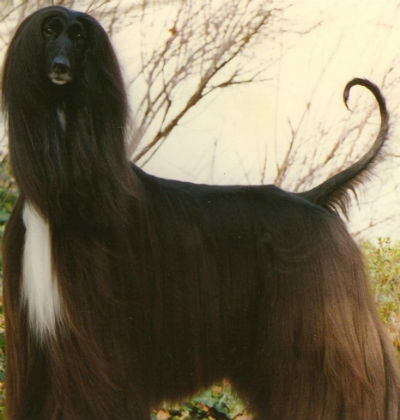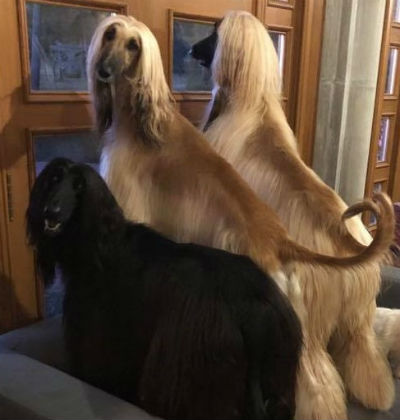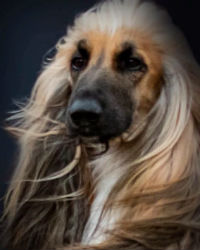Origin and History: The Afghan Hound is an ancient member of the Sighthound family, a king of dogs. They are best described as an athlete in a silk suit. The Afghan Hound is an aristocrat, with his whole appearance being one of dignity and aloofness. The striking characteristics of the breed are an exotic expression, a long silky topknot, a unique coat pattern with profuse trousering, very prominent hipbones, and large feet.
Adult weight: 50-60 lb (22-27 kg)
Adult height: 25- 28 inches in (63-71 cm)
Coat: An Afghan Hound has a profuse silky coat on the legs, head, and body, and a short sleek saddle on the back of a mature dog. They require constant upkeep, and weekly bathing if kept in full coat. For pets, clippering is often done in order to keep the coat both easier to manage, and to keep the dog clean. A dog in a shorter pet trim should be bathed and groomed monthly. This breed has a very different appearance between those kept in full coat as opposed to a pet trim.
Colours: All colours are permissible, but colour combinations are often seen. White markings especially on the head are undesirable on show prospects – however white blazes on their chests or some on their toes are often seen. White should never be a predominant colour.
Feeding: A high quality balanced kibble diet often with added meat or any other protein source assists to encourage appetite. They can be picky eaters, and on their own tend to do well grazing as opposed to eating their meal all at one time. They can be thieves and may counter surf.
Training & Obedience: They are devoted to their family but are not particularly willing to please consistently in performance events. They are very clever at picking up what is expected of them but will do so on their own terms. They require a soft, gentle hand and voice. They are almost catlike in demeanor. Socialization with both people and animals is paramount from a young age.
House breaking and Crate training: Afghan Hounds are a clean breed, and train well in their home. They benefit from a consistent routine. When trained from a young age they are excellent in their crates, and rarely suffer from separation anxiety. They prefer a larger open wire cage to stretch out, with good bedding to protect their back and spine as they often sleep upside down with their legs in the air. A wire crate also allows good air circulation for their coat. A raised water bucket is helpful so they do not end up with wet bedding.
Exercise: They are well suited to both urban and rural homes. They are an excellent walking companion. They are very instinctive hunters. They are best being exercised on leash, or within a fenced area. They are a natural hunter so they are not a breed that is ever reliable to return once off leash.
Weather tolerance: Access to fresh water at all times is important. They can be an all weather dog and do not mind the cold or inclement weather. Saying that if they get wet the hair is inclined to become matted if not thoroughly dried and brushed. As with any other companion they should always live inside the home as a family member.



